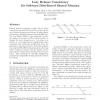Free Online Productivity Tools
i2Speak
i2Symbol
i2OCR
iTex2Img
iWeb2Print
iWeb2Shot
i2Type
iPdf2Split
iPdf2Merge
i2Bopomofo
i2Arabic
i2Style
i2Image
i2PDF
iLatex2Rtf
Sci2ools
ISCA
1992
IEEE
1992
IEEE
Lazy Release Consistency for Software Distributed Shared Memory
Relaxed memory consistency models, such as release consistency, were introduced in order to reduce the impact of remote memory access latency in both software and hardware distributed shared memoryDSM. However, in a software DSM, it is also important to reduce the number of messages and the amount of data exchanged for remote memory access. Lazy release consistency is a new algorithm for implementing release consistency that lazily pulls modi cations across the interconnect only when necessary. Trace-driven simulation using the SPLASH benchmarks indicates that lazy release consistency reduces both the number of messages and the amount of data transferred between processors. These reductions are especially signi cant for programs that exhibit false sharing and make extensive use of locks.
| Added | 10 Aug 2010 |
| Updated | 10 Aug 2010 |
| Type | Conference |
| Year | 1992 |
| Where | ISCA |
| Authors | Peter J. Keleher, Alan L. Cox, Willy Zwaenepoel |
Comments (0)

